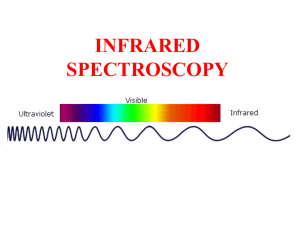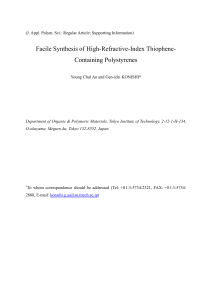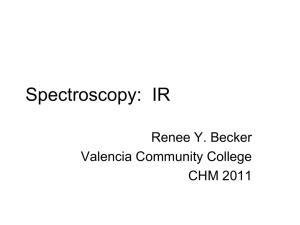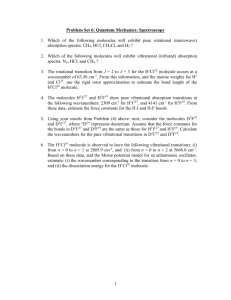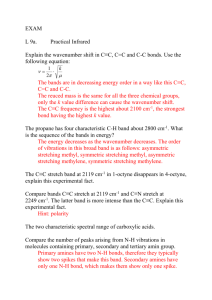PowerPoint
advertisement
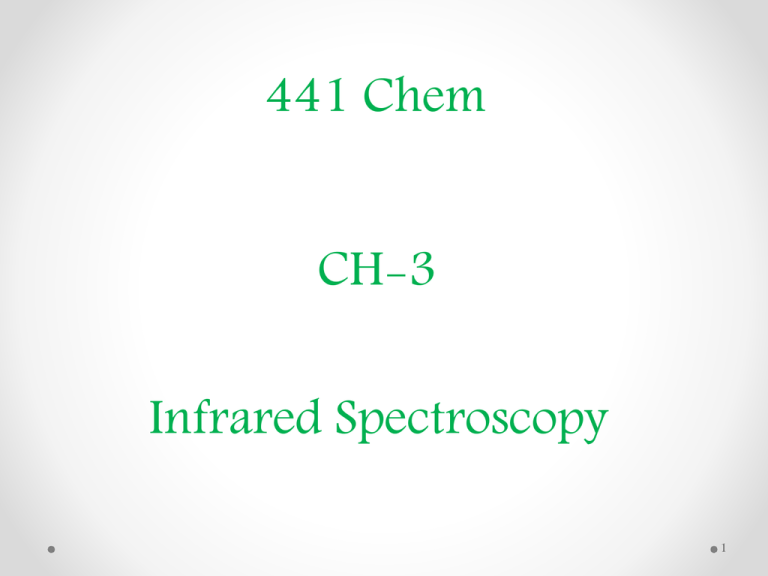
441 Chem CH-3 Infrared Spectroscopy 1 The Electromagnetic Spectrum Frequency (n) high high X-RAY INFRARED MICROWAVE ULTRAVIOLET Vibrational infrared Visible 2.5 mm 400 nm BLUE short low Energy Ultraviolet 200 nm low 15 mm RADIO FREQUENCY Nuclear magnetic resonance 1m 5m 800 nm RED Wavelength (l) long 2 Infrared spectroscopy (IR) measures the bond vibration frequencies in a molecule and is used to determine the functional group. The IR region is divided into three regions: 1. The near IR (12500-4000 cm-1) (overtons region) 2. The mid IR (4000-200 cm-1) 3. The far IR (200-10 cm-1) The mid IR region is of greatest practical use to the organic compounds. 3 The unit used on an IR spectrum is Wavenumbers n n = wavenumbers (cm-1) = 1 l wavelength (cm) n = frequency = nC C = speed of light = 3 x 1010 cm/sec or n =( 1 ) l C = C l cm/sec = cm 1 sec wavenumbers are directly proportional to frequency 4 Simplified Infrared Spectrophotometer NaCl plates focusing mirror Detection Electronics and Computer Determines Frequencies of Infrared Absorbed and plots them on a chart Infrared Source Infrared Spectrum Sample intensity of absorption Absorption “peaks” frequency (decreasing) 5 Molecular Vibrations Molecules are made up of atoms linked by chemical bonds. The movement of atoms and chemical bonds like spring and balls (vibration). There are two main vibrational modes : H 1- Stretching - change in bond length (higher frequency) C Stretching Types: C H C out-of-phase in-phase H C C C H Symmetric Stretch HH H H H C H Asymmetric Stretch 6 2- Bending - change in bond angle (lower frequency) Bending Types: Scissoring H C H Wagging H C C H H H H C C H H H C H Rocking in-plane 3- Fingerprints H Twisting out-of-plane 7 Dipole Moments Only bonds which have significant dipole moments will absorb infrared radiation. Factors that influence in determining the locations of the spectrum peaks various 1. Atomic Masses Frequency decreases with increasing atomic mass. 8 2. Bond Strength Frequency increases with increasing bond energy. 3. The coupling between bonds different groups. 4. stereochemistry effects. 5. Solvents, Temperature and Sample state. 9 Samples 1. Solid :- KBr disk (1 mg solid sample + 100 mg KBr pressed into a disk) - Mull (1 mg solid sample suspended in Nujol (heavy liquid hydrocarbon)) 2. Liquid : Thin film of liquid between two NaCl plates solution in CCl4 and put in special NaCl cells. 3. Gas IR spectrum is obtained directly by permitting the sample to expand into an evacuated special cells. 10 Solvents 1. Must be transparent in the region studied: no single solvent is transparent throughout the entire IR region. 2. Water and alcohols are seldom employed to avoid O-H band of water. 3. Must be chemically inert (does not react with substance or cell holder). CCl4, CS2, or CHCl3; may be used but we should consider its IR spectrum. 11 Describing IR Absorptions IR absorptions are described by their frequency and appearance. Frequency (n) is given in wavenumbers (cm-1) Appearance is qualitative: intensity and shape conventional abbreviations: vs very strong s strong m medium w weak br broad sh sharp or shoulder 12 Index of Hydrogen Deficiency The index is the sum of the number of ring, the number of double bonds and twice the number of triple bonds. Index = carbons – ½ hydrogens – ½ halogens + ½ nitrogens + 1 Example: C6H14 Index = 6 – ½ (14) – ½ (0) + ½ (0) + 1 =6–7+0+1 =0 13 IR Absorption Regions In general, the IR spectrum can be split into four regions for interpretation: 4000 2500 cm-1: Absorption of single bonds formed by hydrogen and other elements e.g. OH, NH, CH 2500 2000 cm-1: Absorption of triple bonds e.g. C≡C, C≡N 2000 1500 cm-1: Absorption of double bonds e.g. C=C, C=O 1500 400 cm-1: This region often consists of many different, complicated bands, called the fingerprint region. It is rarely used for identification of particular functional groups. 14 Summary of IR Absorptions 15 Typical IR Absorption Regions 16 Base Values (+/-10 cm-1) 17 The C-H Stretching Region Base Value = 3000 cm-1 18 19 The C-H Bending Region 20 Alkane Hexane 21 Alkene 1-Hexene 22 Aromatic Toluene 23 Alkyne 1-Hexyne 24 Aldehyde Nonanal 25 The O-H Stretching Region O-H 3600 cm-1 (alcohol, free) O-H 3300 cm-1 (alcohols & acids, H-bonding) 26 Effect of Hydrogen-Bonding on O-H Stretching 1-Butanol 27 Alcohol Cyclohexanol pure solution 28 Carboxylic acid Butanoic Acid pure solution 29 The N-H Stretching Region N-H 3300 - 3400 cm-1 Primary amines give two peaks Secondary amines give one peak Tertiary amines give no peak 30 Primary amine 1-Butanamine 31 Secondary amine N -Ethylbenzenamine 32 Tertiary amine N,N -Dimethylaniline 33 The Triple Bond Stretching Region The cyano group often gives a strong, sharp peak due to its large dipole moment. The carbon-carbon triple bond gives a sharp peak, but it is often weak due to a lack of a dipole. 34 Propanenitrile 35 1-Hexyne 36 The Carbonyl Stretching Region 37 This region stretches from about 1800 to 1650 cm-1 . The base value is 1715 cm-1 (ketone). The bands are very strong !!! due to the large C=O dipole moment. C=O is often one of the strongest peaks in the spectrum. 37 C=O is sensitive to its environment. 38 Factors that influence the C=O absorption Inductive and Resonance effects on the Carbonyl Frequency 39 40 How the Factors affect C=O 41 Confirmation of Functional group Every type of carbonyl compound has other places you can look to confirm your conclusion based on frequency alone. 42 2-Butanone Ketone Base = 1715 43 Aldehyde Base = 1725 Nonanal 44 Acid Chloride Base = 1800 Dodecanoyl Chloride 45 Ester Base = 1735 Ethyl Butanoate 46 Carboxylic acid Base = 1710 2-Methylpropanoic Acid 47 Amide Base = 1690 Propanamide 48 Anhydride Base = 1810 and 1760 Propionic anhydride 1750 1820 49 Conjugation of C=O with C=C Conjugation of a carbonyl with a C=C bond shifts values to lower frequencies. For aldehydes, ketones and esters, subtract about 25-30 cm-1 for conjugation with C=O. Conjugated ketone = 1690 to 1680 cm-1 Conjugated ester = 1710 to 1700 cm-1 C=C becomes quite strong!! 50 51 C=O : 1715 - 30 = 1685 C=C : 1650 - 25 = 1625 Ketone conjugated 4-Methyl-3-penten-2-one 52 C=O : 1715 - 30 = 1685 Aromatic Ketone conjugated Acetophenone 53 Angle Strain raises The Carbonyl Frequency 54 Conjugation and Ring Size Effects 55 Cyclic Ketone 5-ring Cyclopentanone 56 The C=C stretching region C=C double bond at 1650 cm-1 is often weak or not even seen. C=C benzene ring shows peak(s) near 1600 and 1475 cm-1 , one or two at each value - Conjugation lowers the value. When C=C is conjugated with C=O it is stronger and comes at a lower frequency. 57 Alkene 1-Hexene 58 58 Aromatic Toluene 59 The C-O stretching region The C-O band appears in the range of 1300 to 1000 cm-1. Look for one or more strong bands appearing in this range! Ethers, alcohols, esters and carboxylic acids have C-O bands. 60 Ether Base = 1100 Dibutyl Ether 61 Aromatic Ether Base = 1100 Anisole 62 Cyclohexanol Alcohol Base = 3600 Base = 1100 63 Carboxylic acid 2-Methylpropanoic Acid 64 Ester Ethyl Butanoate 65 The N=O stretching region N=O stretching : 1550 and 1350 cm-1 asymmetric and symmetric stretching. Often the 1550 cm-1 peak is stronger than the other one. 66 Nitroalkane 2-Nitropropane 67 The C-X stretching region C-Cl 785 to 540 cm-1, often hard to find amongst the fingerprint bands!! C-Br and C-I appear outside the useful range of infrared spectroscopy. C-F bonds can be found easily, but are not that common. 68 Chlorobenzene 69 C-H Out-of-Plane Bending (OOPS) 1000 to 650 cm-1 900 to 690 cm-1 70 71 72 73 74 75 76 Final Summary 77 The minimum you need to know 78
